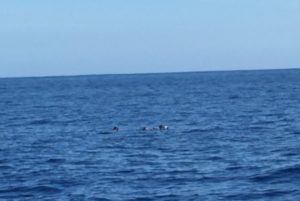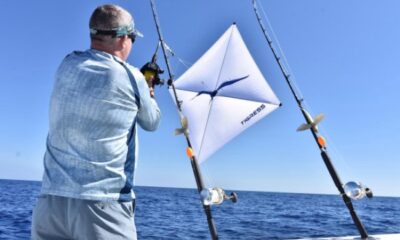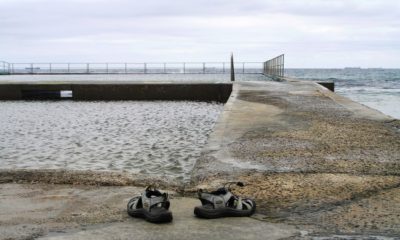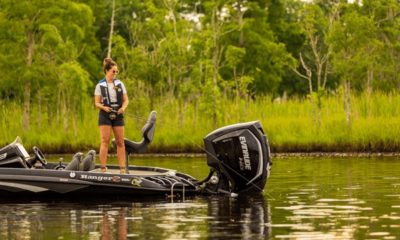Fishing
How to Survive 2 Weeks Adrift at Sea

I wonder if one of the guys started looking like a ham roast to the other guy, like in the cartoons.
A few days ago, the world received the kind of shocking news we love to hear: Two fishermen, presumed lost at sea after having disappeared two weeks prior, were rescued by a Good Samaritan and the Coast Guard. Found 23 miles northeast of Cat Island in the Bahamas (and, interestingly, within the hypotenuse of the infamous Bermuda Triangle), the two Dominican fishermen had miraculously survived 14 days on the open water. Becoming lost at sea is much easier than most boaters and fishermen realize; even experienced old sea hands are subject to equipment failures, navigational trouble, and weather.
So how did they survive all that time? The news reports don’t contain much information about these two specific men, 45-year-old Domingo Jimenez and 29-year-old Ramon Castillo, and what they did. So what we’ll do is start from what we know, and work backwards.
We know that on May 5, Sector San Juan watchstanders received a report from a concerned family member of an overdue 25-foot fishing vessel with two people aboard approximately 132 miles northeast of Samana, Dominican Republic. The two men reportedly departed Samana May 2 to fish and were expected back May 5.
What happened to the two fishermen to cause their daily fishing trip to go so spectacularly sideways? Weather, apparently; a severe storm caused them to lose their outboard engine. Although we’re certainly not going to go blaming these survivors for being caught out in a storm, there’s definitely a lesson there for those of us planning similar seaborne adventures.
Why weren’t they found right away? Well, it can be summed up in four words: “Big Ocean, Little Boat.” The Coast Guard certainly gave it the old college try. The Coast Guard Cutter crews searched for more than 50 hours covering more than 9,690 square miles, nearly the size of Maryland, before they suspended the search on the evening of May 6.
How were they rescued? Mostly happenstance. On May 19, two weeks after the men were supposed to have been home, those same Coast Guard Sector San Juan watchstanders received a report from the good Samaritan vessel Signet Intruder crew, who had seen the two men flagging them down. A Coast Guard Air Station Clearwater MH-60 Jayhawk helicopter crew, forward deployed for Operation Bahamas Turks and Caicos (OPBAT), hoisted Jimenez and Castillo and safely transferred them to Bahamian Authorities in Nassau, Bahamas.
So how would you survive a crisis like the one Jimenez and Castillo endured? Obviously, the first and best answer is “Don’t get in a crisis,” and we’ll have some advice from the Coast Guard on that in a moment. However, that won’t help you if you’re already lost, sharks are circling, and the other guy in the boat is starting to look like a roast Thanksgiving turkey like in those old Warner Brothers cartoons.
Your two worst enemies out on the open water are the sun and dehydration. Despite the WB cartoons’ depictions, humans can live two weeks (or even a little longer) without food. People who have had to endure long periods of starvation report that the hunger actually withers after about 24 hours, and from that point onward it’s mostly a feeling of weakness and lassitude as your body tries to conserve energy.
The sun, on the other hand, can start causing third-degree burns in a matter of hours, even for those who rejoice in ample amounts of melanin. Those burns, left untreated, can quickly go septic. That’s why your on-the-water survival kit must include at least one generously sized tarp. This can be used as a shelter from the sun. It can also be used to collect rainwater and dew for drinking.
Naturally, there’s one more option for hydration that you would be unwise to ignore, disgusting as it is. Let me turn this one over to Bear Grylls for a moment:

Mmm, notes of coffee and asparagus.
Ideally, your tarp will be very brightly colored–preferably with a refractive side or at least something in a high-vis color like blaze orange or neon yellow. This is because your would-be rescuers are most likely to be looking for you from the air, and a gray or neutral-colored tarp might blend into the surrounding ocean. Mirrors are also terrific signaling tools; flare guns work best in low-light conditions.
“These two men were presumed lost at sea but were found and safely rescued because a good Samaritan spotted them,” said Cmdr. Juan M. Hernandez, with Sector San Juan.. “Search and rescue cases are very dynamic and very case to case, which is why it’s imperative that prior to leaving the docks a person needs to file a float plan, have a VHF radio, have proper emergency equipment, like flares and signaling devices, and life jackets.”
Here are some tips boaters can use to have a safe and fun summer on the water:
- Always wear a life jacket. More than two-thirds of recreational boating accidents result in drownings, and, more than 84% of those who drowned were not wearing life jackets.
- Boat sober. Alcohol was the leading factor in boating accidents for 2018. It is illegal to operate a boat while under the influence of alcohol or drugs in every state. Penalties for violating BUI/BWI laws can include large fines, suspension or revocation of boat operator privileges and jail terms.
- Ask the Captain. Before you get underway on a charter, or even pay for the trip, ask the captain to see their credentials. You are putting your life at risk and in danger when you get underway on a charter vessel without a properly credentialed mariner, so you have the right to know the charter is legal.
- Check the weather before going out on the water. Know your weather limitations – what your boat can handle and what it can’t. Check the weather for storms, tides, currents and winds.
- Have an EPIRB. Always go out with an Emergency Position Indicating Radio Beacon. Own it, know it, and register it. An EPIRB is a device that is designed to transmit a distress signal if you get into trouble. No matter where you are in the world, an EPIRB sends a signal to emergency responders through a satellite system.
- Tell someone where you’re going. If you change plans mid-voyage, let someone know! A written float plan should be given to a friend or family member and includes a description of your boat, what is on board and a description of the safety equipment you are carrying.
- Always take a marine radio. A VHF-FM radio is the best method of communication while on the water. Although cell phones are a good backup, they can be unreliable due to gaps in coverage area and the inevitable dead battery.
- Be COVID-19 safe. The National Safe Boating Council offers boaters tips for social distancing and safe boating including: maintaining a safe distance while at the fuel dock, and washing your hands frequently or using a hand sanitizer after touching a marina gate or fuel pump.
Download the free Coast Guard app. Focusing on recreational boating, the app has a float plan function, the ability to check weather reports from the nearest NOAA buoys, a function for calling for assistance when in distress and more. It is currently available for free on iOS and Android devices.
-

 Fishing4 weeks ago
Fishing4 weeks agoWind & Sea: Let’s Go Kite Fishing!
-

 Conservation3 weeks ago
Conservation3 weeks agoAnti-Hunting Activists’ “Long Hike Through the Institutions” Isn’t Hype
-

 Gear1 month ago
Gear1 month agoThis ARF Will Hunt! Rock River Ascendant All-Terrain Hunter Rifle
-

 Camping & Survival2 months ago
Camping & Survival2 months agoDIY Emergency Food: Dehydrators vs. Freeze-Drying
-

 Adventure1 month ago
Adventure1 month agoThe Corona We Wanted: Total Eclipse Tips for April 8, 2024
-

 Adventure2 weeks ago
Adventure2 weeks agoLet’s Gooooo! House Passes EXPLORE Act
-

 Camping & Survival2 months ago
Camping & Survival2 months agoAre You Ready for SPRING BEAR MAYHEM?
-

 Adventure1 week ago
Adventure1 week agoBugling All Elk Volunteers!






